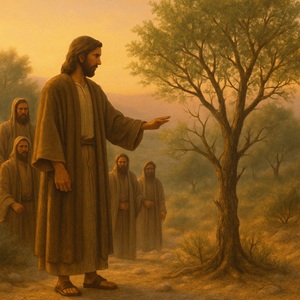
Why Did Jesus Curse the Fig Tree in Mark 11:14?
In Mark 11:13-14, Jesus approaches a fig tree looking for fruit. Finding none, He curses it, despite the text noting, the time of figs was not yet. This act might seem perplexing at first glance, but it carries profound spiritual meaning, particularly in relation to Israel's unfruitfulness and God's unfolding plan to include the Gentiles.
And seeing a fig tree afar off having leaves, he came, if haply he might find any thing thereon: and when he came to it, he found nothing but leaves; for the time of figs was not yet. And Jesus answered and said unto it, No man eat fruit of thee hereafter for ever. And his disciples heard it.
Mark 11:13-14
In the natural world, fig trees typically bear fruit before leaves. The presence of leaves would naturally suggest that some early figs should also be present. However, when Jesus finds the tree having leaves but no fruit, it symbolizes a false appearance of productivity. This fig tree, full of promise on the outside, was barren within. It is a living parable of Israel's spiritual condition - externally religious, yet lacking the true fruit of righteousness and faith.
Throughout the Old Testament, Israel is often represented by a fig tree (see Hosea 9:10, Jeremiah 8:13, Micah 7:1). Jesus' cursing of the tree acts as a prophetic sign of coming judgment upon a nation that had all the signs of faith but bore no fruit. This act is especially significant in light of Jesus' entry into Jerusalem just prior, where He was hailed as king, yet He knew rejection and betrayal were imminent. His action here signals not personal frustration, but a divine indictment against unfaithfulness.
This moment also marks a shift in redemptive history. As Malachi 1:11 foretells, For from the rising of the sun even unto the going down of the same my name shall be great among the Gentiles. Israel's rejection of the Messiah opened the door for the inclusion of the Gentiles into God's covenant, the dawning of the Gentile Church Age we still live in today. This is further explained in Romans 11:25, where Paul writes, blindness in part is happened to Israel, until the fulness of the Gentiles be come in. Thus, the barren fig tree serves as a symbol not only of judgment but of transition - God's salvation would now extend beyond Israel to all nations through Christ.
Interestingly, Jesus bookends this act with the cleansing of the Temple (Mark 11:15-19), further highlighting Israel's lack of spiritual fruit and the failure of its leaders to shepherd the people in truth. Just as the fig tree was cursed for its barrenness, the Temple too was under judgment for becoming a den of thieves instead of a house of prayer.
Ultimately, Jesus' curse of the fig tree was not arbitrary but was a solemn sign - God was not satisfied with outward religion devoid of genuine faith. The judgment upon Israel was not permanent, for as Paul later assures, all Israel shall be saved. (See Romans 11:26) However, in the meantime, the kingdom would be opened to the Gentiles, fulfilling God's promise that His name would be glorified among all peoples.
This account encourages believers today to examine whether our lives bear true fruit or merely leaves. Jesus seeks faith, righteousness, and the fruit of the Spirit - not just religious appearance. And in His great mercy, He invites all, Jew and Gentile alike, into the fullness of His grace.